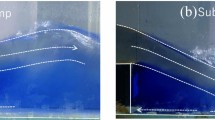Abstract
To understand the processes and energy dissipation performance caused by turbulence during the wave run-up over a stepped revetment, hydraulic model tests with steady flow conditions are conducted and correlated with unsteady flow conditions of the wave run-up within a short time frame. Under irregular waves, the run-up reduction over a stepped revetment is dependent on the Iribarren number and decreases for decreasing Iribarren numbers. Velocity gradients are found to be similar in a steady and unsteady flow regime near the pseudo-bottom.
Similar content being viewed by others
References
Bung, D. B., 2011. Non-intrusive measuring of air-water flow properties in self-aerated stepped spillway flow. 34th IAHR World Congress. Brisbane, 2380–2387.
Bung, D. B., and Valero, D., 2015. Image processing for Bubble Image Velocimetry in self-aerated flows. 36th IAHR World Congress. Den Haag, 6594–6601.
Bung, D. B., and Valero, D., 2016. Image processing techniques for velocity estimation in highly aerated flows: Bubble Image Velocimetry vs. Optical Flow. 4th IAHR Europe Congress. Liege. 151–157.
EurOtop, 2007. European Overtopping Manual. Die Küste, vol. 73. Boyens Mediean GmbH & Co. KG., Heide i. Holstein, 171pp.
Jachowski, R., 1964. Interlocking precast concrete block sea wall. Proceedings of the 9th Conference on Coastal Engineering, Lisbon, Portugal, 504–517.
Kerpen, N. B., and Schlurmann, T., 2014. Experimental investigation on wave overtopping on stepped embankments. Proceedings of the 5th International Conference on Application of Physical Modelling to Port and Coastal Protection, Varna, Bulgaria, Vol. 1: 262–269.
Kerpen, N. B., and Schlurmann, T., 2016. Stepped revetmentsrevisited. Proceedings of the 6th International Conference on Application of Physical Modelling in Coastal and Port Engineering and Science, Ottawa, Canada, 1–10.
Leandro, J., Bung, D. B., and Carvalho, R., 2014. Measuring void fraction and velocity fields of a stepped spillway forming flow using non-intrusive methods. Experiments in Fluids, 55 (5): 1732.
McCartney, B., 1976. Survey of coastal revetment types. Miscellaneous Report No. 76-7, Coastal Engineering Research Center, 1–49.
Nussbaum, P., and Colley, B., 1971. Dam construction and facing with soil cement. Bulletin RD 010.01W, Portland cement association, 111pp.
Ryu, Y., Chang, K.-A., and Lim, H.-J., 2005. Use of bubble image velocimetry for measurement of plunging wave impinging on structure and associated greenwater. Measurement Science and Technology, 16 (10): 1945–1953.
Saville, T., 1957. Wave run-up on composite slopes. Proceedings of the 6th Conference on Coastal Engineering, Miami Beach, 691–699.
Schüttrumpf, H. F., 2001. Wellenüberlaufströmung bei Seedeichen: Experimentelle und theoretische Untersuchungen. In: Mitteilungen aus dem Leichtweiß Institut für Wasserbau. Vol. 149, Braunschweig. 127pp.
Thielicke, W., and Stamhuis, E. J., 2014. PIVlab–Towards userfriendly, affordable and accurate digital Particle Image Velocimetry in MATLAB. Journal of Open Research Software, 2 (1): e30.
van der Meer, J., and Janssen, J., 1995. Wave run-up and wave overtopping at dikes. Wave Forces on Inclined and Vertical Structures, ASCE, 1–27.
Wassing, F., 1957. Model investigations on wave run-up carried out in the Netherlands during the past twenty years. Proceedings of the 6th International Conference on Coastal Engineering, Gainesville, Florida, 700–714.
Acknowledgements
The present work is part of the joint research project ‘waveSTEPS’ funded by the German Federal Ministry of Education and Research (BMBF) through the German Coastal Engineering Research council (KFKI, 03KIS108 and 03KIS119). The authors gratefully acknowledge the support of the experimental work by Kornelius Müller within the wave flume experiments and Jochen Vogel within the current flume experiments.
Author information
Authors and Affiliations
Corresponding author
Rights and permissions
About this article
Cite this article
Kerpen, N.B., Bung, D.B., Valero, D. et al. Energy dissipation within the wave run-up at stepped revetments. J. Ocean Univ. China 16, 649–654 (2017). https://doi.org/10.1007/s11802-017-3355-z
Received:
Revised:
Accepted:
Published:
Issue Date:
DOI: https://doi.org/10.1007/s11802-017-3355-z




